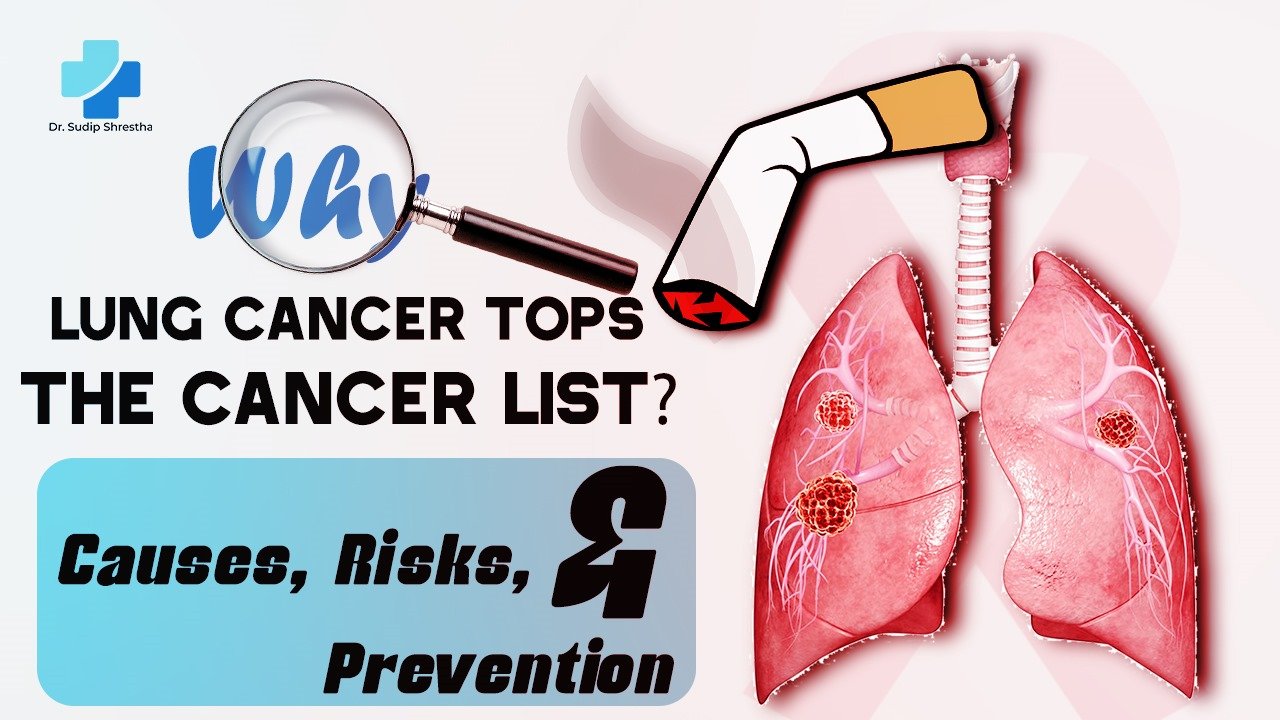Lung cancer remains the leading cause of cancer-related deaths globally, making it the number one cancer in terms of prevalence and mortality. Despite advancements in cancer research, lung cancer continues to pose a significant health challenge. Dr. Sudip Shrestha, a renowned oncologist in Nepal, sheds light on the causes, risks, and prevention strategies that can help combat this formidable disease.
Understanding Lung Cancer
Lung cancer originates in the tissues of the lungs, primarily in the cells lining the air passages. The disease can be broadly categorized into two types:
- Non-Small Cell Lung Cancer (NSCLC): The most common form, accounting for about 85% of cases.
- Small Cell Lung Cancer (SCLC): A less common but more aggressive form of lung cancer.
Dr. Sudip Shrestha emphasizes that understanding the root causes and risks associated with lung cancer is crucial for both prevention and early detection.
Why is Lung Cancer the Number One Cancer?
1. High Prevalence of Smoking
Smoking is the leading cause of lung cancer, responsible for nearly 85% of cases. Cigarette smoke contains over 7,000 chemicals, many of which are carcinogenic. Even second-hand smoke poses a significant risk.
Key Fact: According to studies, individuals who smoke are 15 to 30 times more likely to develop lung cancer than non-smokers.
2. Environmental Pollution
Air pollution, especially in urban areas, contributes significantly to the rising cases of lung cancer. Exposure to fine particulate matter (PM2.5) and carcinogens like asbestos increases the risk.
3. Genetic Predisposition
A family history of lung cancer can increase susceptibility. Genetic mutations, inherited or acquired, often play a role in the development of the disease.
4. Late Diagnosis
Dr. Sudip Shrestha notes that lung cancer is often diagnosed at advanced stages due to subtle symptoms in the early phases, making it harder to treat effectively.
Risk Factors for Lung Cancer
1. Tobacco Use
The longer and more frequently a person smokes, the higher their risk of developing lung cancer. This includes smoking cigarettes, cigars, and pipes.
2. Occupational Hazards
Workers exposed to substances like asbestos, radon, and silica dust are at an increased risk. Construction and mining workers are particularly vulnerable.
3. Exposure to Radon Gas
Radon, a radioactive gas that occurs naturally in the soil, can accumulate in homes and workplaces. Prolonged exposure to high radon levels is a significant risk factor.
4. Chronic Lung Diseases
Conditions such as chronic obstructive pulmonary disease (COPD) or pulmonary fibrosis can increase the likelihood of lung cancer.
5. Lifestyle Factors
A diet lacking in fruits and vegetables, combined with physical inactivity, can weaken the body’s ability to fight carcinogens.
Symptoms to Watch For
Dr. Sudip Shrestha stresses the importance of recognizing early symptoms, as timely diagnosis greatly improves treatment outcomes. Common symptoms include:
- Persistent cough that worsens over time.
- Chest pain or discomfort.
- Shortness of breath or wheezing.
- Unexplained weight loss.
- Coughing up blood.
If you or a loved one experience these symptoms, it’s crucial to consult an oncologist like Dr. Sudip Shrestha promptly.
Prevention Strategies
1. Quit Smoking
Smoking cessation is the most effective way to prevent lung cancer. Resources such as counseling, nicotine replacement therapy, and medications can help individuals quit.
Tip from Dr. Sudip: Avoid exposure to second-hand smoke as much as possible.
2. Reduce Exposure to Pollutants
- Test your home for radon gas and invest in mitigation systems if levels are high.
- Use protective equipment if you work in industries with asbestos or other carcinogens.
3. Adopt a Healthy Lifestyle
- Consume a diet rich in antioxidants, fruits, and vegetables to boost lung health.
- Engage in regular physical activity to strengthen your immune system.
4. Routine Health Check-Ups
Early detection through screening, such as low-dose computed tomography (LDCT), is crucial for high-risk individuals. Dr. Sudip Shrestha offers specialized screenings tailored to patient needs.
5. Vaccinations
Stay updated on vaccinations, such as the flu and pneumonia vaccines, to reduce the risk of infections that may weaken lung function.
Advancements in Treatment
Dr. Sudip Shrestha highlights that modern treatments have significantly improved the prognosis for lung cancer patients. Options include:
- Surgery: For early-stage cancers to remove the affected part of the lung.
- Radiation Therapy: To target and destroy cancer cells.
- Chemotherapy: Used to kill or slow the growth of cancer cells.
- Targeted Therapy: Focuses on specific genetic mutations driving the cancer.
- Immunotherapy: Boosts the immune system to fight cancer cells effectively.
Dr. Shrestha and his team specialize in personalized treatment plans to ensure the best possible outcomes for their patients.
Conclusion
Lung cancer remains the leading cancer due to its strong association with smoking, environmental factors, and genetic predisposition. While its prevalence is alarming, awareness and prevention strategies can significantly reduce the burden of this disease.
Dr. Sudip Shrestha’s expertise and dedication to oncology have helped countless patients understand, prevent, and treat lung cancer effectively. By adopting healthier habits, staying vigilant about symptoms, and seeking regular check-ups, we can take proactive steps toward reducing the impact of lung cancer worldwide.
FAQ About Lung Cancer
Q1. Can a Person Survive Lung Cancer?
Yes, survival is possible, especially if lung cancer is detected early. Factors influencing survival include:
- Stage at Diagnosis: Early-stage lung cancer (Stage 1 or 2) has much higher survival rates than advanced stages.
- Treatment Options: Advances in surgery, chemotherapy, targeted therapy, and immunotherapy have improved outcomes.
- Patient’s Overall Health: Younger, healthier individuals tend to respond better to treatments.
For instance, non-small cell lung cancer diagnosed at Stage 1 has a 5-year survival rate of about 64%. With personalized treatment plans offered by experts like Dr. Sudip Shrestha, patients have better chances of recovery and long-term survival.
Q2. What Are the First Signs of Lung Cancer?
The early signs of lung cancer are often mild and easy to overlook. However, being vigilant about the following symptoms can help in early detection:
- Persistent cough that worsens over time.
- Chest pain or discomfort, especially during deep breathing or coughing.
- Shortness of breath or wheezing.
- Unexplained weight loss or loss of appetite.
- Coughing up blood (even in small amounts).
If you experience any of these symptoms, it’s crucial to consult an oncologist like Dr. Sudip Shrestha immediately. Early diagnosis greatly improves treatment outcomes.
Q3. How Fast Does Lung Cancer Spread?
The speed of lung cancer’s spread depends on its type:
- Small Cell Lung Cancer (SCLC): This aggressive type grows and spreads quickly, often metastasizing to other organs like the brain or liver within weeks to months.
- Non-Small Cell Lung Cancer (NSCLC): It progresses more slowly but can still spread to lymph nodes and distant organs if untreated.
Factors Affecting Spread:
- The cancer’s stage at diagnosis.
- Patient’s immune system and overall health.
- Timeliness and type of treatment.
Early intervention can slow the progression, highlighting the importance of regular screenings for high-risk individuals.
Q4. Can Stage 4 Lung Cancer Be Cured?
While Stage 4 lung cancer is typically not curable, advancements in medical treatments have improved patients’ quality of life and extended survival. At this stage, the cancer has metastasized to other parts of the body, making complete eradication difficult.
Treatment Options for Stage 4:
- Immunotherapy: Boosts the body’s immune response to cancer cells.
- Targeted Therapy: Addresses specific genetic mutations driving the cancer.
- Chemotherapy and Radiation Therapy: Help manage symptoms and slow cancer progression.
- Palliative Care: Focuses on improving quality of life and alleviating discomfort.
Dr. Sudip Shrestha explains that while the 5-year survival rate is low (5-10%), individualized treatment plans can lead to better-than-expected outcomes for some patients.
Q6. What Are the Main Causes and Risk Factors for Lung Cancer?
The leading causes and risk factors include:
- Smoking: The primary cause of lung cancer, with both active smoking and second-hand smoke contributing.
- Radon Gas Exposure: A natural radioactive gas that can accumulate in homes.
- Air Pollution: Prolonged exposure to fine particulate matter (PM2.5) increases risk.
- Occupational Hazards: Jobs involving exposure to asbestos, silica dust, or other carcinogens.
- Genetic Factors: A family history of lung cancer may increase susceptibility.
- Chronic Lung Diseases: Conditions like COPD and pulmonary fibrosis elevate the risk.



